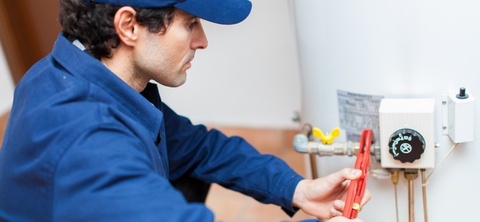There are a few different types of geysers out there:
Electric:
In an electric geyser, water is heated from the centre of the tank, moving outwards. The water temperature is increased and controlled using a high-voltage copper coil that runs through the stainless steel tank converting electricity into heat energy. The tank is fitted with a thermostat to regulate the water temperature. Electric heaters are quite energy efficient, however, once the hot water in the tank is used up then you will have to wait for the next round of water in the tank to heat up before you can enjoy a hot shower.

Plumber installing an electric geyser - Canva Image
Gas:
The water in a gas geyser is heated using liquid petroleum gas. Gas heaters can either have tanks or they can be tankless. They are beneficial in that there is no real limit to the amount of water they can heat providing households with an instant and constant supply of hot water. They are also relatively inexpensive to run and don’t require electricity, however, gas heaters do result in carbon emissions so they are not considered to be very environmentally friendly.

Gas Geyser – Canva & Seaqual Image
Solar:
Solar geysers make use of sunlight to generate the energy necessary to heat a household’s water supply. Solar heaters come in many designs but they all require:
- a thermal panel or solar collector installed on the roof that absorbs sunlight and converts it to energy
- a water storage tank
- a thermal regulator to control the water temperature
- and a circulating pump to carry heated energy from the thermal panel to the tank.
The cost of a solar geyser is initially quite high but in the long run they are exceptionally energy efficient, cost-saving and environmentally friendly.

Solar Geyser – Canva Image
Vacuum Breakers:
But for this month’s blog, we are going to focus on the electric geyser. Electric geysers have an inlet pipe for cold water supply and an outlet pipe for hot water supply and installed on each of these is a vacuum breaker. As the name suggests, vacuum breakers prevent a vacuum from forming inside the geyser. The vacuum breaker will open up allowing air into the piping system thus shutting off the negative pressure, however, these components are notorious for failing. Of course, the most common location for a geyser is in the ceiling and when the vacuum breakers fail, the result is a “sprinkler” effect in the roof (a.k.a. an absolute mess).

Leaking Ceiling – Canva Image
Unfortunately, there is no sure way of preventing a vacuum breaker from failing. A good preventative measure is to employ the services of a skilled and certified plumber to do the initial installation correctly. There are a lot of so-called “plumbers” out there who are performing low-quality and unsafe installations that are not in line with SANS regulations. Give yourself piece of mind by hiring a plumber that is licensed and registered with the Plumbing Industry Registration Board (PIRB) or The Institute of Plumbing South Africa (IOPSA) for example.
At Seaqual, we have developed another way to avoid the destructive aftermath of vacuum breaker failure. It comes in the form of a small plastic device called Ceiling Saver that is quickly and easily installed over the vacuum breakers. In the event of vacuum breaker failure, Ceiling Saver directs the flow of water safely through the overflow pipe and discharges it outside the property preventing flood damage inside the home. We recommend installing one over the inflow and another one over the outflow vacuum breakers of your geyser.

Ceiling Saver Installed on an Electric geyser - Seaqual Image
For the humble price of a pair of Ceiling Savers and the plumber’s installation cost, homeowners can save a ton of frustration, time and inconvenience and the costs associated with a messy repair job. Ceiling Saver can be purchased from most specialist plumbing and DIY building supply outlets in South Africa and if you cannot find any you are welcome to call us on 044 382 3484 and we will tell you where they are stocked.
For more about Ceiling Saver, watch our product video.
Thanks for reading and happy plumbing! :)



